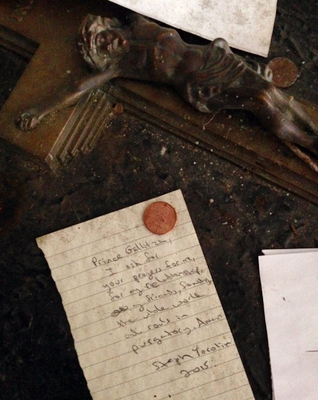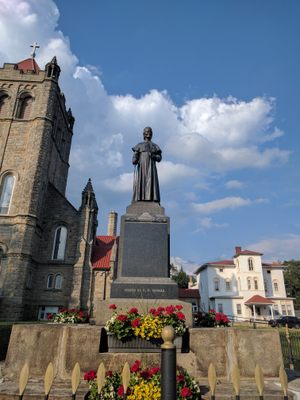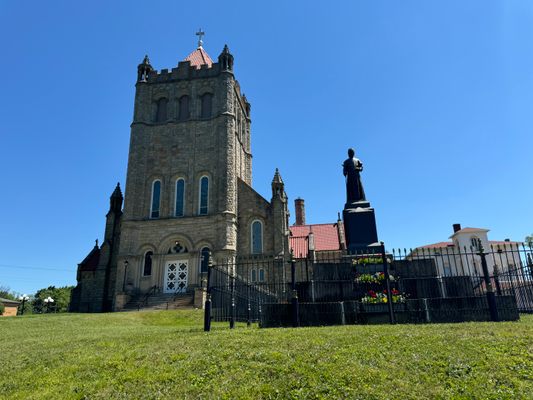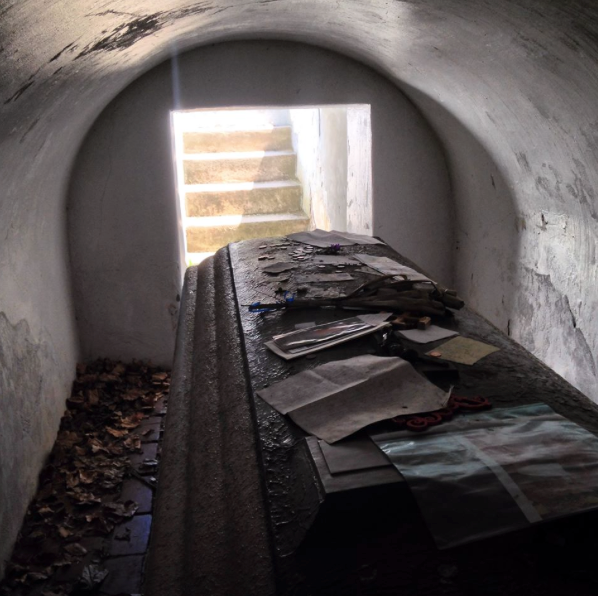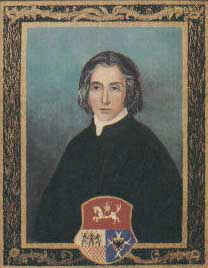About
In a small underground crypt in the Allegheny Mountains lie the mortal remains of a fascinating Russian prince, priest and paranormal investigator who came to America in 1792.
Dubbed the "Apostle to the Alleghenies," Demetrius Gallitzin gave up a life of aristocratic privilege to become a missionary on the farflung American frontier. Mostly forgotten, he's now under consideration for sainthood.
Gallitzin's father, a vulcanologist, art dealer, and diplomat who hailed from one of Russia's greatest noble families, served as Catherine the Great's ambassador to France and Holland. His son was born in The Hague in 1770. (Dmitri Alexeyevich Gallitzin was also a friend of the Enlightenment philosophers Voltaire and Diderot. With the Tsarina's help, in 1766 he bought Diderot's personal library, a collection of 2,900 books that later formed the nucleus of the National Library of Russia.)
The future American missionary was raised in Holland, where like many Russian nobles, he grew up speaking French as his native tongue. When Catherine the Great came for a visit, she cradled the infant in her arms. Like the Empress, Gallitzin's mother was German. One of the leading female figures in the German Enlightenment, Adelheid Amalie von Schmettau hosted some of the great salons that made the Enlightenment famous for intellectual discourse. Gallitzin's mother, however, turned away from the new philosophy and became a fervent Catholic in 1786. Raised nominally Russian Orthodox, Gallitzin converted at age 17.
This didn't sit well with the boy's diplomat father, who had planned a military career for him in St. Petersburg. Nor did it please the Russian government. When the French Revolution broke out and aristocratic heads began to roll, Princess Gallitzin arranged for her 22-year-old son to travel to America for a few years. Not wanting to be known as a Russian prince in the new republic, the well-educated young nobleman traveled under a pseudonym.
To his father's further horror, Gallitzin became a Catholic priest in Baltimore in 1795. First stationed at a parish on Chesapeake Bay, he went on to Conewago, a frontier Catholic settlement near Gettysburg. The young priest's work took him all over the Blue Ridge and Allegheny mountains and deep into northern Virginia and Pennsylvania.
One especially colorful event in the young priest's life came just after his ordination, when he spent three months investigating a bizarre Appalachian ghost story.
Around 1792, a traveler came to stay at Adam Livingston's roadside inn in the small town of Smithfield, Virginia (today Middleway, West Virginia, near Harpers Ferry.) The traveler took sick and was on the point of death. He begged his host to quickly get a Catholic priest so he could receive the last rites and make a final confession. Priests were hard to come by in this part of Virginia at the time -- and as Gallitzin later wrote, the innkeeper was "an intensely bigoted Lutheran" who wasn't keen on finding one anyway, even to help a man at death's door. The unknown traveler died, leaving nothing in his possession to reveal his identity. Livingston buried the mystery man in unholy ground.
Soon, the inn began to be terrorized by a strange, scissor-wielding spirit. The ghost came and went, clipping half-moons and other weird patterns into fabric and clothing. Coats, shirts, bedsheets, even leather shoes were reduced to shreds. Yet only the sound of cutting could be heard. The ghost itself was never seen. For a couple of years, Livingston went almost insane, and it was said that no day went by without a visit from "The Wizzard Clip." Curious visitors came to check out the ghost. Skeptics were turned into believers when stones were flung out of the fireplace, crockery burst, and even a lady's fancy shawl -- tucked away for safety in her purse beforehand -- was cut to ribbons. (Or so the story goes.)
Livingston tried various Protestant ministers, even an Appalachian folk conjurer, all to no avail. Eventually he had a powerful dream in which he saw a man wearing robes, then heard a voice saying "This is the man who can help you." When the innkeeper went to Sheperdstown to seek help for an exorcism, he at last visited a tiny Catholic church. To his shock and disbelief, the local priest there, an Irishman named Dennis Cahill, proved to be the man he'd seen in his dream. Cahill celebrated mass at the inn for the soul of the dead man, after which the spook went away. The relieved Livingston deeded 35 acres of his farm to the Catholic Church.
The ghost story immediately became famous in the region, and Demetrius Gallitzin decided to investigate it. For three months in 1794, he came and spoke to people in the West Virginia Panhandle about "The Wizzard Clip" hauntings and, though a skeptic at first, he became convinced the tale was true. Unfortunately, his popular handwritten account, never copied, was lost in the 1790s.
In 1799, Gallitzin went north into the Alleghenies to Loretto, Pennsylvania, which had once been the only English-speaking Catholic settlement west of Baltimore. (There were others, but they all spoke French.) To honor his Russian roots, he named the chapel he built there after St. Michael the Archangel. In the meantime, he'd lost his inheritance: Russian law forbade Catholic priests from inheriting property. Though Gallitzin was considered for the bishoprics of Philadelphia, Pittsburgh, Cincinnati and Detroit, he spent the rest of his life in poverty in a remote part of Appalachia, serving a tiny community, traveling from valley to valley to minister to settlers -- and not only to Catholics. Gallitzin died at Loretto on May 6, 1840, just after Easter.
His body lay in the earth until around 1900, when the Pittsburgh steel magnate Charles Schwab, who was raised in Loretto, paid for a large new church to be built there–as well as an elaborate statue and crypt to honor the bones of Father Gallitzin. Today, you can walk down into this tiny crypt, which sits directly underneath the statue right in front of the church. (If you're tall, you'll need to duck down, though, as the space containing the priest's bones is only about five feet high.)
The cast-iron vault holding what's left of this wandering Russian nobleman is covered in hand-written letters. It's a strange and fascinating sight to see prayer requests written on modern American stationery–one of them bearing the logo of a Comfort Inn & Suites–addressed to a man who had been held in the arms of Catherine the Great as a child, letters asking him to intercede with God to cure cancer, heal broken marriages, and help one petitioner simply become a better person.
The back roads of Appalachia are full of surprises, but the Gallitzin crypt is surely one of the most unexpected.
Related Tags
Know Before You Go
Loretto, Pennsylvania, is an hour and a half east of Pittsburgh and 2 1/2 hours northwest of Gettysburg. There's tons of other surprising history in the area, too: Arctic explorer Robert Peary, who claimed to be the first man to reach the North Pole, was born just four miles down the road in the former mountain resort town of Cresson.
The Prince Gallitzin Chapel House, which has some interesting historic artifacts from his time, sits next to the Loretto cemetery, but the museum doesn't post regular hours and is often closed.
Community Contributors
Added By
Edited By
Published
May 31, 2016






